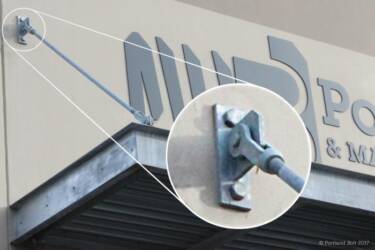How do tie rods attach to a structure?
 Tie rods are attached by sliding a gusset plate or knife plate, which is fastened to a structure, in between the ears of a clevis. A clevis pin or A325 structural bolt, is then assembled through the pin holes on the clevis and through the hole in the plate. Gusset plates are attached to the structure by through bolts or lag screws. The gusset plates are designed by an engineer with the proper quantity and size of bolts necessary to secure the gusset plate to the structure and develop the full strength of the assembly.
Tie rods are attached by sliding a gusset plate or knife plate, which is fastened to a structure, in between the ears of a clevis. A clevis pin or A325 structural bolt, is then assembled through the pin holes on the clevis and through the hole in the plate. Gusset plates are attached to the structure by through bolts or lag screws. The gusset plates are designed by an engineer with the proper quantity and size of bolts necessary to secure the gusset plate to the structure and develop the full strength of the assembly.
A clevis is threaded onto either end of an externally threaded rod to form a tie rod assembly. These parts function as a tension rod because at one end, a clevis threads onto left-hand threads, and on the other end a clevis threads onto right-hand threads. These oppositely threaded ends allow the tie rod to be tightened or loosened by turning the rod in the middle.
Portland Bolt provides attachment plates. However, due to liability issues, we cannot assist in the design of these plates. Please provide a detailed sketch of the plate size, hole sizes, and hole locations and we will be happy to include the attachment plates with the tie rod assemblies.

Need some help with architectural rod details for exterior and interior of new residential construction in Colorado, zip 81623.
@Lori- we are happy to assist if we can. You can call us during business hours (6a-5pm M-F) or send us information via email at sales@portlandbolt.com
i am needing this entire assembly (clevis, threaded rod, bolts) for an awning project that i am trying to build for our office. can someone please contact me about placing an order to make sure i get everything i need. thanks
@Thomas- One of our salespeople will be contacting you shortly.